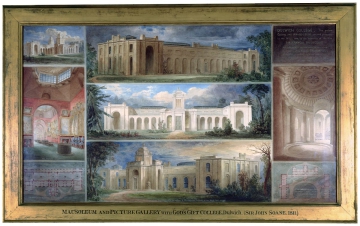
Browse
Reference number
Purpose
Aspect
Inscribed
Signed and dated
- datable to 1823?
Medium and dimensions
Hand
Watermark
Notes
From 1835 the drawing has been displayed in the North Drawing Room of 13 Lincoln's Inn Fields (inside plane on south wall). Some of these views offer the only record of the appearance of the building when it was first opened to the public. The title refers to the criticism of Reverend T. F. Dibdin; 'say what you please, and you cannot say anything so delightfully monstrous as is the exterior in question' and 'a maeso-gothic, semi-arabic, moro-spanish, an anglico-norman - a 'what you will' production!' (The Museum, volume 1, London, 1822).
Soane published in many forms the building he had wanted, in comparison to that executed, and this can be seen in the comparison views in the top left, centre and bottom right of this composite drawing. Soane was restricted in his design by funds and not by a lack of imagination and he wanted to ensure that his ideal schemes were recognised.
The drawings in the top left and centre show the more elaborate designs for the Gallery. The view in the top left shows the previous design to have a projecting two-storey entrance porch on the east to mirror the structure of the Mausoleum on the west and an open arcade. The top central drawing, in contrast, shows the east front as executed. In this view the entrance is just a door within a recessed arch and the arcade is in a much reduced style. The central bottom drawing shows the west front as executed. It reveals the round-topped sash windows finally chosen for the almshouses. Bottom right is the plan of the Gallery as a central feature within the proposed quadrangle. However the porch, the arcade on the east and the south range were never built. Bottom right is an enlarged plan of the Gallery, as if viewed from Gallery Road. The interior views of the Gallery and Mausoleum are very important for revealing the original internal structure. The centre left shows the five-bay enfilade of the Gallery, the red walls, the green oil-cloth floor, the octagonal skylights and the steam heaters in the centre of the rooms. However the initial colour of the gallery walls was burnt ochre and it was not until 1829 that Soane had them repainted red at his own expense. The centre right shows the cupola of the Mausoleum antechamber with Greek Doric columns leading to the top-lit burial chamber with the sarcophagi.
There is some uncertainty about the date of this drawing as there is no date inscribed on it. It is possible that it was executed in 1811 judging by the inscription on the frame. The bottom left plan corresponds to plans drawn following the meeting on 15 November 1811 agreeing to move the Mausoleum to the west front (see SM 65/4/49) so it could have been painted in late 1811. However the inscription on the frame was probably added at a later date, and actually refers to the fact that Soane began work at Dulwich College in 1811. The painting is a collaboration of ideal designs and designs as built so it is more likely that it was executed once building work was complete in 1813. Or perhaps it was painted during construction as the titles often refer to the 'present unfinished state'. It appears that this painting was exhibited at the Royal Academy in 1823, which suggests it was actually painted at an even later date. It is possible that Soane re-used an existing drawing to exhibit at the Royal Academy. However the painting could have been wholey inspired by the criticisms of Reverend T. F. Dibdin who made his statement in The Museum a journal which was only published 1822-1824. As he is referred to in the title of the painting this would corroborate the idea that it was painted in 1822-1823.
An enlarged copy of the central drawing can be found at the Dulwich Picture Gallery (DPG G44). An enlarged copy of the top left drawing can be found at the Victoria and Albert Museum (V&A 3307.108). Both of these paintings are undated and in the hand of Gandy.
Literature
C. Davies, 'Masters of building: the first independent purpose-built picture gallery: Dulwich Picture Gallery', Architect's Journal, April 1984, p. 56
F. Nevola, Soane's favourite subject: the story of Dulwich Picture Gallery, 2000, pp. 117 & 194-195
M. Richardson & M. Stevens (ed.), John Soane architect: master of space and light, Royal Academy of Arts, 1999, pp. 184-185
Level
Sir John Soane's collection includes some 30,000 architectural, design and topographical drawings which is a very important resource for scholars worldwide. His was the first architect’s collection to attempt to preserve the best in design for the architectural profession in the future, and it did so by assembling as exemplars surviving drawings by great Renaissance masters and by the leading architects in Britain in the 17th and 18th centuries and his near contemporaries such as Sir William Chambers, Robert Adam and George Dance the Younger. These drawings sit side by side with 9,000 drawings in Soane’s own hand or those of the pupils in his office, covering his early work as a student, his time in Italy and the drawings produced in the course of his architectural practice from 1780 until the 1830s.
Browse (via the vertical menu to the left) and search results for Drawings include a mixture of Concise catalogue records – drawn from an outline list of the collection – and fuller records where drawings have been catalogued in more detail (an ongoing process).

